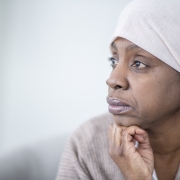Three Facts About Cancer in African American Communities
It starts by recognizing cancer disparities unique to each population.
Because of the genetic makeup of tumors, cancer affects individuals differently. Other factors that alter the way an individual experiences cancer include sex and gender, lifestyle, geography and income among others. These are explained as the social determinants of health or, more specifically, cancer disparities. Race is also an underlying determinant that can put certain populations at higher risk of being diagnosed with certain cancers.
Related: Racial Disparities in Cancer Care and Research: The Causes and Possible Solutions
African Americans are part of one of the largest minority populations in the United States (an estimated 46.9 million people). According to US-HCC, this group also reports the highest cancer mortality rate, despite the decline in cancer incidence rates, of any other racial population. These striking statistics have become the basis for the drive across the healthcare industry to implement initiatives to reduce healthcare disparities and ensure every individual has equitable access to the care they need to treat their disease at every stage.
For example, Black women are more likely to be diagnosed with breast cancer, triple-negative breast cancer, and inflammatory breast cancer. Additionally, they are at higher risk for developing lung and colorectal cancers. Black men are diagnosed more often with lung and bronchus cancer as well as prostate, colon and rectum cancers than other populations.
Here are three facts about cancer among the African American population.
- This population reports a lower cancer screening rate compared to their counterparts. Frequent cancer screenings, as recommended by physicians, can help detect tumors in the early stage and before they have had time to develop. As a result of delayed and, in some cases no, screenings, late-stage diagnoses are more common, which has allowed time for the tumor to develop and spread. The higher rate of inaccessible and quality healthcare services and being uninsured as well as an increased level of medical mistrust are only just a few reasons why screenings are low for this population.
- The five-year survival rate for certain cancers is lower for African Americans. Cancer is often found in advanced stages that are more challenging to treat, which increases the risk of mortality. In fact, Black men have a 19% higher mortality than White men, and Black women have a 12% higher mortality rate than their counterparts. The survival rates are impacted by the barriers to timely care and accessible cancer treatment centers in addition to other cancer disparities.
- There is an underrepresentation of African Americans in clinical trials. Diversity in cancer treatment trials is critical in learning how certain therapies impact specific populations. However, African Americans are less likely to be participants in these studies for various reasons including economic factors, unawareness of available trials and mistrust. Diversifying the participants who enroll in trials provides insights into the efficacy of treatments.
Related: The Benefits of Clinical Trials at Community Practices
Early detection through frequent screenings makes a difference in whether cancer therapies are successful or not. By recognizing the disparities populations face, such as the African American community, physicians and healthcare teams can work toward creating more inclusive services that enhance the health and well-being of many.
American Oncology Network (AON) works to bridge the gap cancer disparities have created by addressing them head-on. Through both innovative initiatives and simple processes such as increasing communication about available clinical trials and providing support and resources to help patients throughout their cancer journey, AON is dedicated to actively closing the cancer care gap — making cancer care and therapies accessible to more Americans.
To locate an AON partner oncology practice, visit aoncology.com/locations/.








